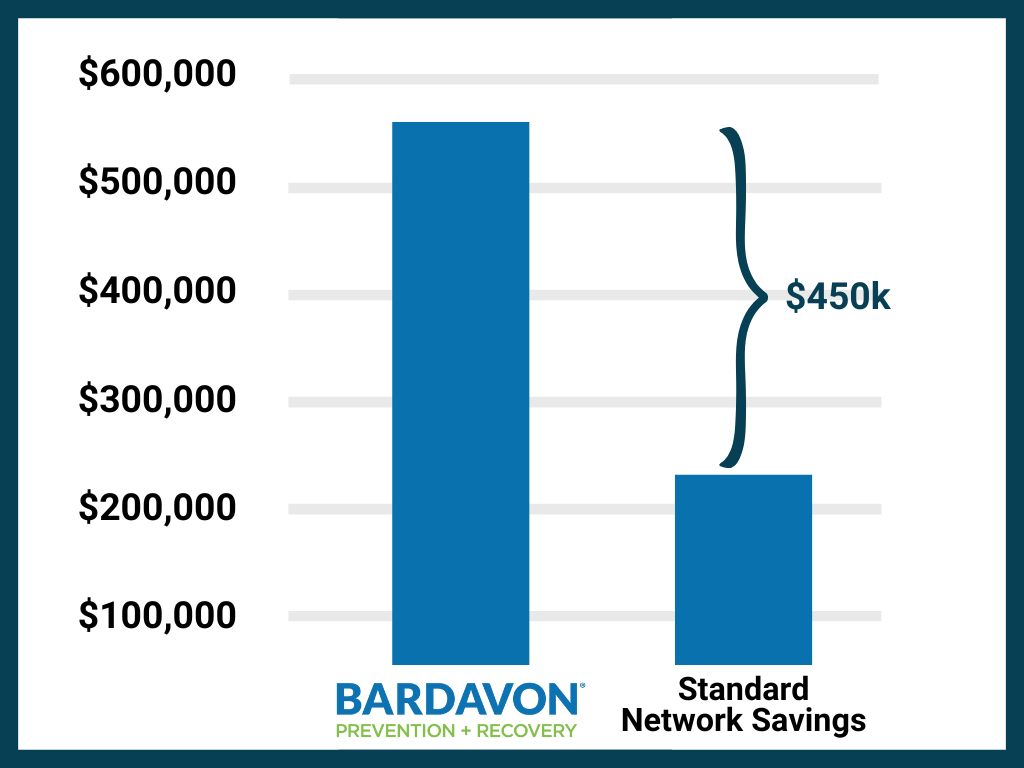In workers’ compensation, employers are responsible for managing the health and return to work of all workers injured on the job.
In today’s post-pandemic climate, employers are finding themselves in a difficult employment environment filling their open positions, keeping employees on the job, and running their businesses smoothly. Now, imagine layering in the inevitable (and unfortunate) cost of production and resources with a workplace injury.
When musculoskeletal injuries do happen in the workplace, medical inflation and the risk of super claims are the current reality. Super claims are defined as “extreme time and cost for a single injured worker.” Super claims are more likely to occur in outlier cases, which take up more time and money than the average. These surging super claims are increasingly common and are responsible for driving up costs and affecting the return to work of employees.
Meanwhile, with a 20-year high “quit rate” across the U.S., record employee churn, and inflated costs to train and retain new employees, the health and wellness of each worker are more important than ever. After all, our employees are our greatest resource, responsible for keeping businesses running and products and services moving.
Excluding the myriad of other benefits of better healthcare, offering stronger prevention and rehabilitation care solutions to employees is critical for the sake of employee retention alone. Driving appropriate and efficient musculoskeletal solutions in the workplace to keep employees healthy (and working) matters more than ever.
The Critical Need for “Precision-Driven Rehabilitation” for Your Workers
Employers are inundated with choices when it comes to building the best workers’ compensation or risk and safety plan for their employees. One of the most important decisions that is often overlooked is choosing where injured employees will complete their physical recovery.
Only second to orthopedic surgeons, physical therapists are the most skilled in evaluating and managing musculoskeletal conditions. Physical therapists play an even more involved role than most other physician types. With the majority of work injuries being musculoskeletal in nature, physical and occupational therapists are best positioned to help injured workers restore their movement abilities.
Using quality physical therapy is critical to ensuring workers, as the employer’s most costly and valuable assets, get individualized care that will improve return-to-work and recovery times.
What is Precision-Driven Rehabilitation? The ability to use clinically validated data to drive more tailored and personalized care. For instance, data analytics is used to set care length expectations, customize recovery goals, determine work readiness, and construct a data-backed rehabilitation plan.
When selecting a physical therapy partner for any workers’ compensation program, quality matters. Employers should seek network providers who offer more than traditional physical therapy. This means partnering with physical and occupational therapy networks that offer a full suite of services, leverage innovative and proven technologies, and utilize data to drive critical recovery decisions and care plans. Precision-driven rehabilitation represents solutions that are hybrid and embrace digital and human-driven care.
With Bardavon’s precision-driven rehabilitation model, data steers timely and impactful care decisions with accuracy. Data is leveraged both qualitatively and quantitatively to alert providers on which patients may need more careful monitoring, who have complex injuries or risky comorbidities, and even how authorized PT/OT visits should be portioned to maximize recovery. Our precision-driven rehabilitation solutions predict risk, alert for digital and human intervention, and ultimately allow for deeper personalized care management, providing a more effective solution than one-size-fits-all treatment options.
In addition, to support integrated care, therapists in Bardavon’s provider network document in our proprietary system, where key clinical and return-to-work care decisions are housed and efficiently communicated. All stakeholders involved in the injured workers’ care (such as medical physicians, nurse case managers, and claims examiners) receive full documentation and weekly snapshots through shared data collection, intuitive display, and alert notifications. This information flow allows stakeholders to understand pertinent patient progress more clearly.
Through precision-driven rehabilitation, injured workers benefit from a personalized care experience that encourages them to be active participants in their recovery. In addition, key stakeholders are able to steer care and make informed, real-time decisions to support each worker when it matters most.
Results: How Precision-Driven Rehabilitation Offers ROI
Bardavon performed a study comparing the recovery outcomes and reduction in expensive outlier claims amongst two injured worker cohorts. One of the cohorts was given access to Bardavon’s Digital Health Platform alongside traditional in-person physical therapy. The second cohort was only provided with traditional in-person physical therapy.
The second cohort was only provided with the existing systems used by therapy providers for all patient types.
What is Bardavon’s Digital Health Platform? The combination of a nationwide network of therapy providers and tech-guided care with a unique clinical guidance system at its core. More specifically, the cohort had access to provider network partners guided by technology that helped them make data-driven decisions.
This study was performed over a 24-month period in the same geographic region with workers in similar industries. The study showed that the first cohort who utilized the Digital Health Platform experienced significantly fewer outlier claims.
In fact, the frequency of outlier claims—those where utilization is within the top 15th percentile of claims with the same medical diagnosis—was reduced by 50%. Therefore, there was a 50% reduction in claims that are associated with the longest duration and highest total claim cost.
By reducing the number of outlier claims by 50% out of 100 total claims with physical therapy, there is a cost savings of $450,000. These savings are in addition to the general savings that a workers’ compensation network provides in the form of savings below Fee Schedule and UCR amounts and the savings in visits saved below authorized visits (Clinical Savings).
These cost savings are based on our estimation of the increase in therapy costs and other medical expenses in an outlier case over a non-outlier case. We used claims data from some of our clients to estimate the cost difference to be an average of $50,000 per claim. By saving nine claims from becoming an outlier, the overall program savings are $450,000 (9 * 50,000).
On Program size of 500 claims total (20% with therapy)

- Fee Schedule and Clinical Savings are very similar across networks.
- Bardavon’s Digital Health Platform enables proactive claims management, which provides significant additional savings.
- Reduced spending on therapy
- Reduced total claim cost
- Numbers shown do not reflect additional savings of indirect costs provided by reducing lost time associated with MSK injuries.
Conclusion
The health and mobility of our workers are more important than ever. Treating injuries by leveraging precision-driven rehabilitation through digital health platforms that enhance traditional in-person care is proven to reduce outlier claims.
When quality, contemporary health care solutions are invested in, employers see reduced spend on therapy, lower total claims costs, significant indirect cost savings, and even set the foundation to prevent future musculoskeletal injuries and reinjuries.
Learn more about preventing workplace injuries and Bardavon’s Injury Prevention Suite.
References
- Ferguson, S. (2023, April 7). Understanding America’s labor shortage: The most impacted industries. U.S. Chamber of Commerce. Retrieved April 12, 2023, from https://www.uschamber.com/workforce/understanding-americas-labor-shortage-the-most-impacted-industries
- US Inflation Calculator. (2023, April 12). Health care inflation in the United States. US Inflation Calculator | Easily calculate how the buying power of the U.S. dollar has changed from 1913 to 2023. Get inflation rates and U.S. inflation news. Retrieved April 12, 2023, from https://www.usinflationcalculator.com/inflation/health-care-inflation-in-the-united-states/
- Walls, M. (2023, March 7). Walls: Unprecedented Severity of Workers’ Comp Claims. WorkCompCentral. Retrieved April 12, 2023, from https://www.workcompcentral.com/news/article/id/793b831d2dbf73f22e078961f63ab01d7b635699
- Childs, J. D., Whitman, J. M., Sizer, P. S., & Pugia, M. L. (2005, February). A Description of Physical Therapists’ Knowledge in Managing Musculoskeletal Conditions. ResearchGate. Retrieved April 12, 2023, from https://www.researchgate.net/publication/7780612_A_Description_of_Physical_Therapists’_Knowledge_in_Managing_Musculoskeletal_Conditions
- Occupational Health and Safety. (2020, February 13). The Relationship between MSDs and the Workplace. Occupational Health & Safety. Retrieved April 12, 2023, from https://ohsonline.com/articles/2020/02/13/the-relationship-between-msds-and-the-workplace.aspx

